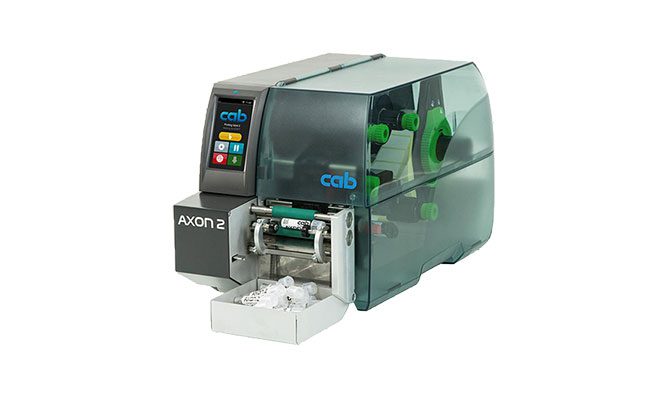Automating your labware identification process can bring numerous benefits, including improved speed, precision label placement, and the ability to reallocate employees to tasks more relevant to your goals.
The decision to integrate automation into your processes can be difficult. It typically involves capital investment, real estate assessment, and considerations about current workflows.
To help you choose the best automatic label applicator for your lab, we’ve put together this list of our top five microwell plate, tube, and vial label applicators. Let’s get to it!
1. cab Axon 1
Recently released by cab—the Axon 1 utilizes thermal transfer print technology to apply a durable barcode directly to your tubes and vials.
Tubes insert vertically, allowing easy integration into your processes—manual or automated. Specialized rollers ensure your label placement is secure and precise.
Additionally, this applicator features print resolutions up to 600 dpi, which means you can expect high scannability even on the smallest 2D barcodes. With a tube diameter range of 10-35mm, a broad range of tube and vial sizes can be accommodated, with caps on or off.
There are also some optional features, including bulk intake or a robotic arm, to decrease operator involvement at an economical price.
2. cab Axon 2
The Axon 2 is another tube and vial applicator offered by cab, released in 2019. This applicator has become popular due to its efficiency and budget-friendly price point.
The Axon 2 allows the operator to place the tube horizontally and quickly and accurately apply the label. The specialized rollers ensure your label is applied securely to reduce the likelihood of a lost sample.
Similar to the Axon 1, the Axon 2 offers durable thermal transfer print technology and print resolution up to 600 dpi to accommodate smaller 2D barcodes. It’s also capable of labeling a relatively broad range of tube sizes—between 10 and 20 mm in diameter and up to 120 mm in length.
3. cab S3200 Microplate Applicator
Utilizing the peel and present model of cab’s SQUIX printer as a base—the S3200 features an additional applicator pad and arm which rotates to the appropriate height, placing your label securely and accurately onto your microwell plate.
The S3200 features the same print capabilities and familiar interface as the SQUIX printer, providing a user-friendly experience, durable thermal transfer print technology, and resolution up to 600 dpi.
The S3200 can utilize a tamp pad and a blow pad to apply labels while your plate is at rest, though a blow pad can accommodate labels in motion, making it a great choice if you need to integrate with existing automation.
An approximate calculation by cab states this system can place up to 20 labels per minute—but speed varies between operators and integrated automation.
4. cab Hermes Q
You may be already familiar with the Hermes Q—an industrial printer offered by cab well known for its dependable performance.
Numerous application options are available for the Hermes Q, two of which are especially useful in the lab. The Hermes Q has different label applicator arms available to either suit microwell plates or cylindrical labware – such as tubes, vials, bottles, etcetera.
The microwell plate applicator offers two application options to suit different needs. Discuss your needs with your automation specialist to determine which will suit your lab.
The tube and vial option utilizes a unique silicon applicator to accommodate various cylindrical labware sizes. Both applicators improve efficiencies, ensure precise label placement, provide high print quality, and easily integrate into existing workflows.
5. Analytik Jena CyBio QuadPrint
Analytik Jena’s CyBio QuadPrint is a plate labeling work cell for high-volume applications.
Capable of walk-away operation, the QuadPrint allows your team to quickly and efficiently label plates while focusing on other tasks around your facility—even if variable data is required.
Labels are placed precisely and scanned to verify usability for improved downstream workflows. Plate templates can be stored within the system to transition between various plate dimensions easily.
As a more extensive work cell automation system, this equipment is best suited for facilities where real estate is available, with high processing volumes.
Contact us
As we prefaced in the beginning, choosing the right automation solution for your application can be difficult. We hope this list gives you a better idea of which applicators are worth considering in your lab.
If you have questions about any of the applicators on this list, don’t hesitate to get in touch with our team of experts.













